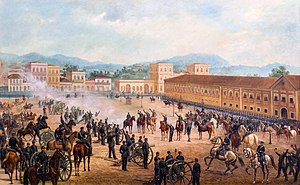
Back Proclamació de la República Brasilera Catalan Διακήρυξη της Δημοκρατίας (Βραζιλία) Greek Proclamación de la República (Brasil) Spanish Proclamation de la république au Brésil French Proklamasi Republik Brasil ID Proclamatie van de Republiek Brazilië Dutch Proclamação da República do Brasil Portuguese Провозглашение Бразильской республики Russian Vyhlásenie republiky v Brazílii Slovak Brasilianska republikens utropande 1889 Swedish
This article has been translated from the article Proclamação da República do Brasil in the Portuguese Wikipedia, and requires proofreading. (August 2022) |
This article needs additional citations for verification. (January 2021) |
| Proclamation of the Republic | |||||||
|---|---|---|---|---|---|---|---|
 Proclamation of the Republic, by Benedito Calixto (1893) | |||||||
| |||||||
| Belligerents | |||||||
|
|
| ||||||
| Commanders and leaders | |||||||
|
| |||||||
| Casualties and losses | |||||||
| 1 wounded[1] | |||||||
The Proclamation of the Republic (Portuguese: Proclamação da República), Coup of 1889 (Golpe de 1889), or Coup of the Republic (Golpe da República) was a military coup d'état that established the First Brazilian Republic on November 15, 1889. It took over the constitutional monarchy of the Empire of Brazil and ended the reign of Emperor Pedro II.
The coup took place in Rio de Janeiro, the capital of the Empire at the time, when a group of military officers of the Imperial Army, led by Marshal Deodoro da Fonseca, staged a coup d'état without the use of violence, deposing Emperor Pedro II and the President of the Council of Ministers of the Empire, the Viscount of Ouro Preto.
A provisional government was established that same day, 15th of November, with Marshal Deodoro da Fonseca as President of the Republic and head of the interim Government.
- ^ Castro, Celso (2012). Exército e nação: estudos sobre a história do exército brasileiro [Army and nation: studies on the history of the Brazilian army] (in Brazilian Portuguese) (1a. ed.). Rio de Janeiro, RJ, Brasil: Editora FGV. p. 13. ISBN 978-85-225-0983-6. OCLC 798726059.